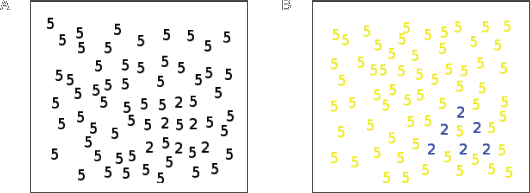Synesthesia
8 Synesthesia as a Perceptual Phenomenon
It has still not been sufficiently explained what gives rise to synesthetic perceptions. By means of psychophysical experiments, it has at least been proven that synesthesia is a perceptual phenomenon, as synesthetic colors can generate certain perceptual effects. If one, for example, arranges twos in a triangle among fives, a color-grapheme synesthete immediately recognizes the triangle, because it stands out in terms of color (pop-out effect), whereas non-synesthetes only recognize a tangle of digits (see fig. 1). It has not yet been conclusively clarified whether the geometric forms actually pop out or whether synesthetes are more competent in solving a task like this. If one has synesthetes search for a digit between other digits (e.g., a two among fives), the time they require to find it depends on the total number of digits presented (Edquist at al. 2006). This indicates that the color of the number does not pop out, but that synesthetes like non-synesthetes have to visually sift through all the digits before they can identify the ones they are searching for.
Also, a synesthetic Stroop effect can be provoked when synesthetes are confronted with words in color (Bergfeld-Mills et al. 1999). Due to the conflict between the actual color of the words and the color of the synesthetic reaction, they require more time to select and name the color that is being shown. Thus one can draw the conclusion that the synesthetic perception of color occurs automatically and involuntarily; in other words, it cannot be suppressed.
However, Mattingley was able to demonstrate that a presentation of colors in such quick succession (28 or 56 milliseconds) that they become imperceptible (priming) does not elicit color photisms (Mattingley et al. 2006). This indicates that conscious perception is necessary for the synesthetic generation of colors.
Whether or not synesthetic perception requires visual attention is still disputed.
By distracting synesthetes with difficult tasks, Mattingley was able to prove that attention modifies synesthetic perception. Ramachandran, on the other hand, established that the generation of color is also possible without visual attention. He used the so-called crowding task, in which numbers surrounded by other numbers appear in the peripheral field of vision and have to be named by the test persons. Because of their restricted resources of attention in the peripheral field of vision, non-synesthetes were not in a position to identify the number in the center, whereas synesthetes were able to recognize the numbers through their synesthetic color, although the number was identified unconsciously, without visual attention (Ramachandran and Hubbard 2003). It was furthermore ascertained that color perception is context-dependent. In the presence of other letters, for example, the symbol I is the same color as the letter I, whereas in the presence of other numbers it has the color of the number 1.

Fig. 1: Modified after Ramachandran et al. 2003: Figure consisting of twos in randomly assembled fives A) from the perspective of a non-synesthete, and B) from the possible perspective of a synesthete.


